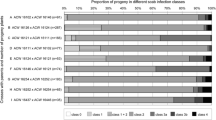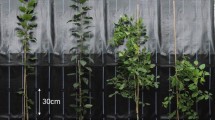Abstract
To study inheritance of Malus sieboldii-derived apple proliferation resistance, 14 cross combinations were performed with the tetraploid apomictic M. sieboldii and first and second generation parental lines as donor of resistance and Malus x domestica scion cultivars and apple rootstocks as donor of pomological traits. In the progeny examined mainly three classes were present consisting of mother-like plants with the allele composition of the maternal apomict (ML), hybrids based on fertilization of an unreduced egg cell (hybrid I), and fully recombinant plants (hybrid II). Two-year screening of inoculated plants in the nursery revealed that progeny classes ML and H I responded similarly to infection and that about half of the progeny showed satisfactory resistance. No appropriate resistance was identified in progeny class H II. This might be due to the fact that in fully recombinant offspring M. sieboldii haplotypes have been reduced from 4n to 1-2n or were entirely lost. Following nursery-growing, promising trees were evaluated for six more years in the orchard. Nearly all of them showed satisfactory resistance but were mostly less productive and more vigorous than trees on clonal standard rootstock M9. However, mainly among the offspring of progeny 4608 × M9, resistant genotypes were identified showing pomological properties similar to M9.

Similar content being viewed by others
References
Ahrens, U., & Seemüller, E. (1994). Detection of mycoplasmalike organisms in declining oaks by polymerase chain reaction. European Journal of Forest Pathology, 24, 55–63.
Baric, S., Berger, J., Cainelli, C., Kerschbamer, C., Letschka, T., & Dalla Via, J. (2011). Seasonal colonisation of apple trees by ‘Candidatus Phytoplasma mali’ revealed by a new quantitative TaqMan real-time PCR approach. European Journal of Plant Pathology, 129, 455–467.
Batjer, L. P., & Schneider, H. (1960). Relation of pear decline to rootstocks and sieve-tube necrosis. Proceedings of the American Society of Horticultural Science, 76, 85–97.
Bisognin, C., Schneider, B., Salm, H., Grando, M. S., Jarausch, W., Moll, E., & Seemüller, E. (2008). Apple proliferation resistance in apomictic rootstocks and its relationship to phytoplasma concentration and simple sequence repeat genotypes. Phytopathology, 98, 153–158.
Bisognin, C., Seemüller, E., Citterio, S., Velasco, R., Grando, M. S., & Jarausch, W. (2009). Use of SSR markers to assess sexual vs. apomictic origin and ploidy level of breeding progeny derived from crosses of apple proliferation-resistant Malus sieboldii and its hybrids with Malus x domestica cultivars. Plant Breeding, 128, 507–513.
Ciccotti, A. M., Bianchedi, P. L., Bragagna, P., Deromedi, M., Filippi, M., Forno, F., & Mattedi, L. (2007). Transmission of ‘Candidatus Phytoplasma mali’ by root bridges under natural and experimental conditions. Bulletin of Insectology, 60, 387–388.
Ciccotti, A. M., Bisognin, C., Battocletti, I., Salvadori, A., Herdemertens, M., & Jarausch, W. (2008). Micropropagation of apple proliferation-resistant apomictic Malus sieboldii genotypes. Agronomy Research, 6, 445–458.
Ciccotti, A. M., Bisognin, C., Battocletti, I., Deromedi, M., Bragagna, P., & Filippi, M. (2011). Response of apple proliferation-resistant Malus sieboldii hybrids to multiple infections with latent apple viruses. Bulletin of Insectology, 64(Suppl), S273–S274.
Cooper, J. I., & Jones, A. T. (1983). Responses of plants to viruses: proposals for the use of terms. Phytopathology, 73(Suppl. 2), 127–128.
Dosba, F., Lansac, M., Mazy, K., Garnier, M., & Eyquard, J. P. (1991). Incidence of different diseases associated with mycoplasma-like organisms in different species of Prunus. Acta Horticulturae, 283, 311–320.
Frisinghelli, C., Delaiti, L., Grando, M. S., Forti, D., & Vindimian, M. E. (2000). Cacopsylla costalis (Flor 1861), as a vector of apple proliferation in Trentino. Journal of Phytopathology, 148, 425–431.
Jarausch, W., Eyquard, J. P., Lansac, M., Mohns, M., & Dosba, F. (2000). Susceptibility and tolerance of new French Prunus domestica cultivars to European stone fruit yellows phytoplasmas. Journal of Phytopathology, 148(148), 489–493.
Kartte, S., & Seemüller, E. (1988). Variable response within the genus Malus to the apple proliferation disease. Journal of Plant Disease and Plant Protection, 95, 25–34.
Kartte, S., & Seemüller, E. (1991). Susceptibility of grafted Malus taxa and hybrids to apple proliferation disease. Journal of Phytopathology, 131, 137–148.
Kison, H., & Seemüller, E. (2001). Differences in strain virulence of the European stone fruit yellows phytoplasma and susceptibility of stone fruit trees on various rootstocks to this pathogen. Journal of Phytopathology, 149, 533–541.
Lenth, R. V. (2016). Least-squares means: the R package lsmeans. Journal of Statistical Software, 69, 1–33.
Liebenberg, A., Kappis, A., Barth, J., Weiter, M., Herdemertens, M., Wetzel, T., & Jarausch, W. (2013). Use of micropropagated Malus to study latent apple viruses. Petria, 22, 393–398.
Morvan, G. (1977). Apricot chlorotic leaf roll. EPPO Bulletin, 7, 37–55.
Moser, M., Musetti, R., Velasco, R., & Jarausch, W. (2011). Gene expression analysis and cytochemical investigations in ‘Candidatus Phytoplasma mali’-resistant and -susceptible Malus genotypes grown in vitro. Bulletin of Insectology, 64, S161–S162.
Oldén, E. J. (1953). Sexual and apomictic seed formation in M. sieboldii Rehd. Botaniska Notisser, 1, 105–128.
R Core Team. (2016). R: a language and environment for statistical computing. Vienna: R Foundation for Statistical Computing URL https://www.R-project.org.
Rott, M. E., & Jelkmann, W. (2001). Characterization and detection of serveral filamentous viruses of cherry: adaptation of an alternative cloning method (DOP-PCR), and modification of an RNA extraction protocol. European Journal of Plant Pathology, 107, 411–420.
Schaper, U., & Seemüller, E. (1982). Condition of the phloem and the persistence of mycoplasmalike organisms associated with apple proliferation and pear decline. Phytopathology, 72, 736–742.
Schaper, U., & Seemüller, E. (1984). Recolonization of the stem of apple proliferation and pear decline-diseased trees by the causal organisms in spring. Journal of Plant Disease and Plant Protection, 91, 608–613.
Schmidt, H. (1964). Beiträge zur Züchtung apomiktischer Apfelunterlagen. I. Zytogenetische und embryogische untersuchungen. Zeitschrift für Pflanzenzüchtung, 52, 27–102.
Schmidt, H. (1972). Reaction of 25 apomictic apple rootstock selections to inoculation with mixtures of ‘latent’ viruses. Journal of Horticultural Science, 47, 151–157.
Schmidt, H. (1977). Contributions on the breeding of apomictic apple stocks. 4. On the inheritance of apomixis. Zeitschrift für Pflanzenzüchtung, 78, 3–12.
Seemüller, E., & Harries, H. (2010). Plant resistance. In P. G. Weintraub & P. Jones (Eds.), Phytoplasmas: genomes, plant hosts and vectors (pp. 147–169). Wallingford: CABI Publishing.
Seemüller, E., & Schneider, B. (2007). Differences in virulence and genomic features of strains of ‘Candidatus Phytoplasma mali’, the apple proliferation agent. Phytopathology, 97, 964–970.
Seemüller, E., Schaper, U., & Zimbelmann, F. (1984). Seasonal variation in the colonization patterns of mycoplasmalike organisms associated with apple proliferation and pear decline. Journal of Plant Disease and Plant Protection, 91, 371–382.
Seemüller, E., Kartte, S., & Kunze, L. (1992). Resistance in established and experimental apple rootstocks to apple proliferation disease. Acta Horticulturae, 309, 245–251.
Seemüller, E., Moll, E., & Schneider, B. (2008). Apple proliferation resistance of Malus sieboldii-based rootstocks in comparison to rootstocks derived from other Malus species. European Journal of Plant Pathology, 121, 109–119.
Seemüller, E., Moll, E., & Schneider, B. (2009). Pear decline resistance in progenies of Pyrus taxa used as rootstocks. European Journal of Plant Pathology, 123, 217–223.
Tedeschi, R., & Alma, A. (2004). Transmission of apple proliferation phytoplasma by Cacopsylla melanoneura (Homoptera: Psyllidae). Journal of Economic Entomology, 97, 8–13.
Westwood, M., & Lombard, P. B. (1982). Rootstocks for pear. Proceedings of the Oregon Horticultural Society, 73, 64–79.
Acknowledgments
We are indebted to late Hanna Schmidt for providing most of the apomictic genotypes used in this project and her engaged support of the breeding work. We thank Stella Grando and Claudia Bisognin (Fondazione E. Mach, San Michele, Italy) for providing unpublished SSR data. We also thank Felix Hergenhahn for his excellence in growing and inoculating the planting material and Constance Berwarth for technical assistance.
Funding
This study was in part supported by the Province of Trentino, Italy (Project Scopazzi del Melo – Apple Proliferation, SMAP). The major part was funded by the institutions of the authors themselves.
Author information
Authors and Affiliations
Corresponding author
Ethics declarations
The manuscript has not been submitted to another journal for simultaneous consideration.
The manuscript has not been published previously. However, several extended abstracts on the breeding approach have been published between 2007 and 2010. These abstracts do not contain any concrete data. Thus, the present manuscript contains the entire data which are true and accurate to the knowledge of the authors.
A single study is not split up into several parts to increase the quantity of submissions and submitted to various journals or to one journal over time.
Any work (data, text, or theories) of others besides the authors has been properly acknowledged.
All authors (including their responsible authorities) listed in the title page agreed to be named as authors on this manuscript.
Authors whose names appear on the submission have contributed sufficiently to the scientific work and therefore share collective responsibility and accountability for the results.
Authors ensure the correct author group, corresponding author, and order of authors at submission.
Authors are aware that changes of authorship or in the order of authors are not accepted after acceptance of a manuscript.
Authors are aware that upon request they should be prepared to send relevant documentation or data in order to verify the validity of the results.
Authors are aware of the COPE guidelines.
Conflict of interest
The authors declare that they have no conflict of interest.
Informed consent
Informed consent was obtained from all individual participants included in the study.
Rights and permissions
About this article
Cite this article
Seemüller, E., Gallinger, J., Jelkmann, W. et al. Inheritance of apple proliferation resistance by parental lines of apomictic Malus sieboldii as donor of resistance in rootstock breeding. Eur J Plant Pathol 151, 767–779 (2018). https://doi.org/10.1007/s10658-017-1412-5
Accepted:
Published:
Issue Date:
DOI: https://doi.org/10.1007/s10658-017-1412-5




